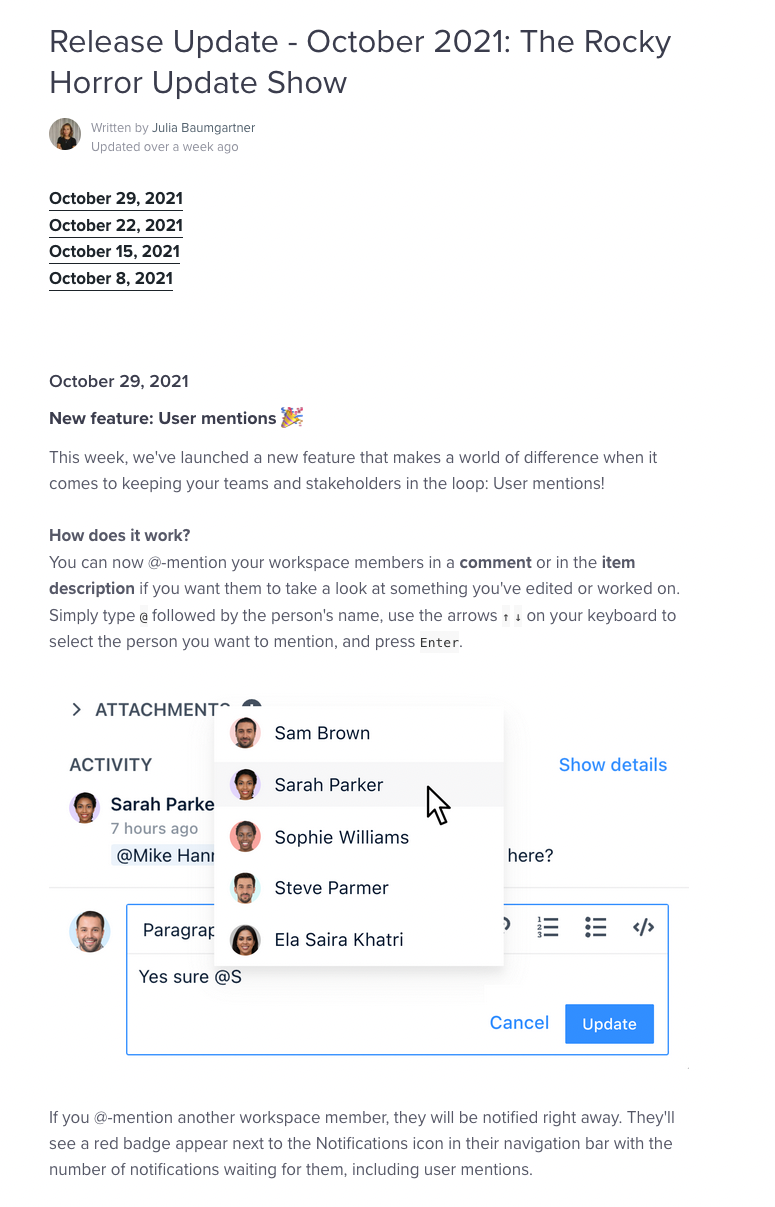Release notes are the most undervalued pieces of growth bypassed by most teams. Most often seen as boring documents to write, they’re treated as an afterthought of the product development process.
If this sounds familiar, let me let you in on a little secret: you’re seriously missing out.
Release notes can be used to your advantage to drive adoption, increase growth, and build trust and transparency with your community.
Let’s review!
Nobody reads my release notes!
You may be thinking nobody cares about your release updates, and maybe you’re right. Not everybody will be reading them, but those that do will be your most engaged users and powerful advocates.
I myself used to think nobody read them, until the time I stopped writing them due to a big internal update that required no external communication. That’s when a bunch of concerned customers reached out asking if the product was shutting down due to lack of development. That’s when I knew, there’s a hidden value here.
Adam Sigel, VP of Product at Hometap says this about release notes:
“Release notes are a really interesting engagement opportunity to me — most people don’t read them, but those that do represent a highly targeted audience of very engaged users. Every company with an app has to write them, and I love to see who treats it like an opportunity instead of a chore.”
If you’re still not convinced, let’s look at a few more reasons why you should start making use of them.

Keeping things organized
I’ve worked with teams that didn’t even keep internal release notes together, or if they did, they weren’t organized. Release notes were often kept in development tools with little access to the rest of the team, and it was hard to track down when and how things were done.
This is your opportunity to show all product-related updates both internally and externally. Not only does this allow your customers to keep track of development progress, but it also allows your business-facing teams to relay updates to customers and leads they might be working with.
Boost customer engagement
Building trust is part of customer engagement. You want to be able to show you’re not static and are continuously working on things, whether that be optimizations, bug fixes, as well as new development.
Publishing updates will increase transparency and give you the opportunity to let your customers know you’re taking in their feedback. (Side note, please also send them a personal email if you can, don’t underestimate the impact and importance of that!)
These “minor bugs and fixes” may not be minor afterall, and you never know how long people have been waiting for an update. If anything, the disregard that something may be ‘minor’ could end up backfiring on you - little bugs all over the place could be adding up to a bad experience that results in a lack of retention and increased churn.
Support-led growth
If you didn’t think this was a thing, it’s absolutely a thing. And no, it most certainly is not a made up term.
“Support-driven growth is a business approach aimed at shifting the customer support channel from cost center to critical revenue driver.
The approach reflects a shift in the market wherein customer-centric companies are leveraging their support teams toward revenue-generating activities.” - Help Scout
Part of support-led growth involves being proactive about retention, and that’s where your release notes come in. Instead of waiting for someone to ask if something has been released, get ahead of the game and be proactive about communication. Trust me, your customers will thank you.
Improve adoption
For me, the biggest part of having weekly release notes is to improve adoption. (And yes, I do write them weekly - more on that later!)
Release notes are a great way of collating all the great stuff you’re working on, not just to show what you are doing, but why and what the benefits are.
Of course, your release notes also have to be seen in order to improve adoption alongside all the points mentioned. You don’t just drop them into the ether and hope someone will pick up on them.

How to write release notes
Ok, so let’s get to the good stuff.
I like to structure my release updates into sections:
New features (Your new shiny objects)
Updates and improvements (Ongoing improvements to existing features)
Bug fixes (What have you fixed?)
Maintenance and optimizations (Any performance improvements or security updates?)
The key here is to really focus on what and why these things were done and to outline the benefits. You don’t just want to say “we released a new CSV export” - cool, but why? How does that help the user? What does it help them achieve?
Think of your release updates as a mini press release. This is your opportunity to have a soft launch. Every time you publish them, you have the opportunity to re-engage and capture people’s attention and remind them of why they chose your product.
Release notes are also a great opportunity to show off your brand and sense of humor. Here’s the thing - no one wants to read a dry document that just says “minor bugs and fixes” - so please don’t do that!
If you can afford to push the boundaries a little bit, have some fun!

What happens if I have nothing to talk about?
You probably do. Even little wins should be celebrated, no matter how minor they may seem.
Remember, that “little bug” may have been a major annoyance for someone.
But if you really find yourself not having anything to talk about, let your users know why. Are you working on a super secret project? Perhaps give them a teaser and reassure them you are still working on updates.
The key here is to remain transparent and not go on stealth mode. Nobody likes that.
Frequency and accessibility of release notes
There’s two important things to consider when preparing release notes - frequency and accessibility.
Frequency
Depending on the frequency at which your team is releasing, you and your customers might find it overwhelming to see a new release update every single day.
Instead, try to select a single day of the week to update your monthly release document. If you want to post a round up on a Friday afternoon or Monday morning, this gives you time to prepare assets, images, and any videos that are needed as part of your public release.
And this brings me to a really important point: Release updates and documentation should not be an afterthought.
Make your release doc process and documentation update part of your development/QA plans. Let it be part of the process. There is nothing more embarrassing than a team that doesn’t know what is going on in their own app.
Don’t let customers find out first that there’s something new, so prepare everyone on the front lines with what they need to know, how it works, and prepare documentation with enough time.
Accessibility
We all know the saying.. If a tree falls in the forest and no one is there to hear it….
Well it’s the same with release notes. If you put them out there but nobody can find them, what’s the point?
Make sure your release updates are all easily findable and accessible to your customers.
If possible, add it within your product’s help section with a direct line to the release section.
When releasing a major new update, try adding in-app guidance that still links back to your release notes. This will give you the opportunity to get their attention further as to all the other things you’ve been working on.
You might also want to take advantage of SEO. Your Help Center is getting indexed by Google, so be sure that all of your images, videos, and docs are optimized to be easily findable. You never know when someone is looking for something you’re there to provide a solution for.

Andrea Saez

Read also
Create effective product strategy





